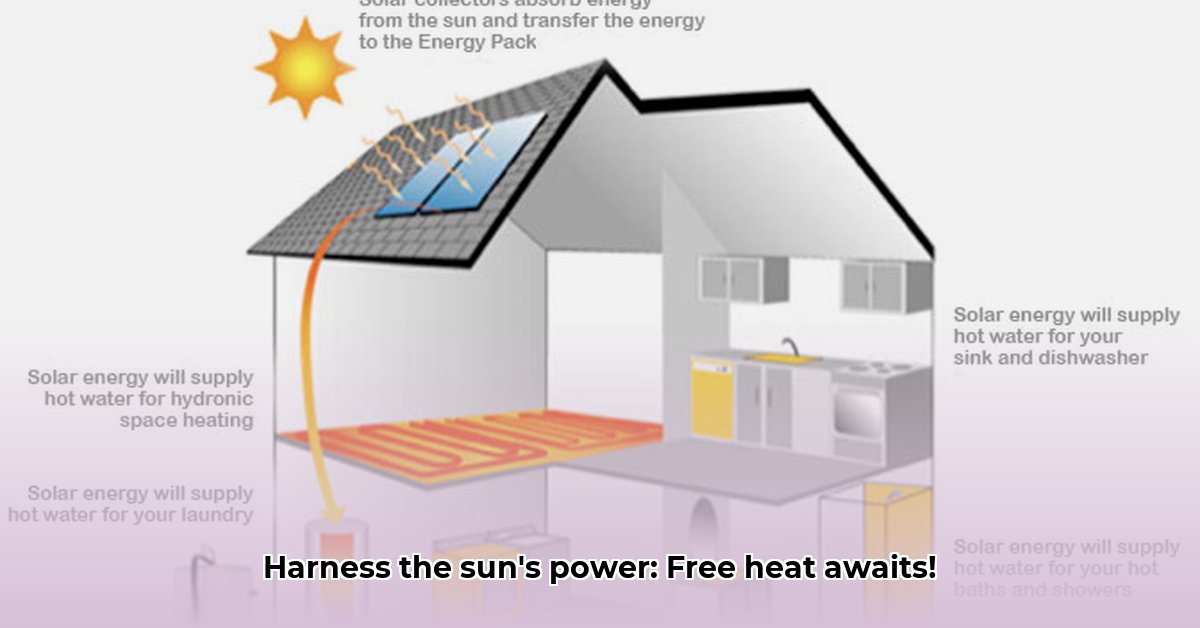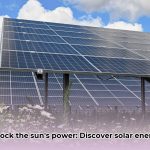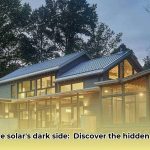Thinking about harnessing solar power for more than just electricity? This guide dives into solar thermal energy – using sunlight directly to heat things up! We’ll explore its use in power plants and smaller systems for homes/businesses. You’ll learn about technologies, pros/cons, installation, maintenance, and cost considerations, whether you’re a homeowner reducing bills or a business exploring sustainable options. For more on solar technology, see this helpful resource.
Understanding Solar Thermal Energy
Solar thermal energy utilizes sunlight to generate heat, offering a practical and sustainable way to power homes and businesses. This guide explores how it works, its applications, benefits, and provides insights into solar thermal investments. Solar thermal systems capture the sun’s radiant energy and convert it into usable heat through various technologies. This heat can then be used for diverse purposes, ranging from heating water for domestic use to driving industrial processes and even generating electricity.
Concentrating Solar Power (CSP): Harnessing Sunlight for Electricity
Concentrated solar power (CSP) systems harness the sun’s energy to generate electricity on a large scale. CSP plants use mirrors to concentrate sunlight onto a receiver, creating intense heat. This heat boils water, generating steam that spins turbines connected to generators, similar to traditional power plants but fueled by solar energy.
There are several CSP technologies:
- Parabolic Troughs: These systems use long, curved mirrors to focus sunlight onto a central tube filled with a heat-transfer fluid. The heated fluid generates steam, which drives turbines to produce electricity. Parabolic troughs are a mature and reliable CSP technology but require significant land area.
- Solar Power Towers: Solar power towers utilize a field of mirrors, called heliostats, to track the sun and reflect its rays onto a receiver positioned atop a tall tower. The concentrated sunlight heats a fluid in the receiver, generating steam for electricity production. These systems can achieve incredibly high temperatures and often incorporate thermal energy storage for electricity generation, even when the sun isn’t shining.
- Solar Dish/Engine Systems: These systems employ dish-shaped mirrors to focus sunlight onto a small receiver linked to an engine, typically a Stirling engine. The engine converts the heat into mechanical energy, which drives a generator to produce electricity. Solar dish/engine systems offer high efficiency but have not yet been widely implemented on a large scale.
CSP Technologies Compared:
| Technology | Operating Temperature (°F) | Efficiency (Sunlight to Electricity) | Scalability | Cost (Relative) | Advantages | Disadvantages |
|---|---|---|---|---|---|---|
| Parabolic Trough | 750+ | 15-20% | High | Moderate | Mature technology, reliable, commercially proven | Requires large land area |
| Solar Power Tower | 1500+ | 20-30% | High | High | High efficiency, potential for thermal energy storage | Higher capital cost, complex system |
| Solar Dish/Engine | 1380+ | 25-35% | Low (Demonstration) | High | Very high efficiency, modular design | Limited commercial deployment, higher maintenance requirements |
Note: Actual costs and efficiency can vary based on specific system design, location, and other factors. Ongoing research and development efforts are focused on improving the performance and lowering the costs of CSP technologies.
Solar Thermal Heating: Direct Use of Solar Heat
Solar thermal technology can also be used to heat water and buildings directly, providing renewable heat solutions for residential and commercial applications. These systems are generally less complex and more cost-effective than CSP plants.
- Solar Water Heating: Solar water heating systems use solar collectors to absorb solar energy and heat water for domestic use. These systems are cost-effective for reducing reliance on traditional water heating methods.
- Active Solar Heating: Active solar heating systems use collectors to absorb solar radiation, and pumps circulate a fluid through the collectors, distributing the heat throughout a building. These systems can work even on less sunny days and supplement existing heating systems.
- Passive Solar Heating: Passive solar heating involves designing buildings to maximize sunlight absorption during winter and minimize heat gain during summer. Proper orientation, window placement, and the use of thermal mass materials can create a natural heating effect, reducing the need for mechanical heating systems.
Solar Thermal Systems: Advantages and Disadvantages
Solar thermal systems offer significant advantages but also have limitations to consider before investing.
Pros:
- Renewable and Sustainable: Solar thermal systems utilize free, abundant sunlight, reducing dependence on fossil fuels and lowering environmental impact.
- Cost Savings: Reduce energy bills for heating water and/or buildings and can provide a return on investment over time.
- Eco-Friendly: Have a lower carbon footprint compared to traditional fossil fuel-based systems, contributing to a cleaner environment.
- Technology Advancements: Ongoing research and development continuously improve efficiency and lower costs, making solar thermal more accessible.
Cons:
- Weather Dependent: Cloudy days or periods of low sunlight limit the amount of heat generated, requiring backup systems.
- Upfront Investment: The initial cost of installing solar thermal systems can be substantial, but government incentives and financing options can help offset the cost.
- Space Requirements: Large-scale CSP systems consume considerable land, while smaller systems require adequate roof space for collector installation.
- Location Matters: Performance is best in areas with abundant sunshine, making location a crucial factor in system design and efficiency.
Taking Action: Solar Thermal Energy Adoption
The move to solar thermal energy can be driven by individuals, businesses, and governments through targeted actions and policies.
| Stakeholder | Short-Term Actions (0-1 Year) | Long-Term Actions (3-5 Years) |
|---|---|---|
| Utilities | Explore hybrid systems combining solar thermal with other energy sources; pilot projects on new CSP technologies to evaluate potential. | Implement large-scale CSP projects; integrate them into smarter grids for reliable energy distribution. |
| Homeowners | Investigate solar water heating systems or passive heating design features for new builds or renovations. | Consider upgrading insulation and active solar heating systems for additional energy efficiency gains. |
| Businesses | Research solar options when developing new energy plans. | Secure financing or grants for solar implementation. |
| Governments | Offer incentives such as tax breaks or subsidies to encourage solar adoption and reduce upfront costs. | Fund research into advanced solar thermal and energy storage technologies; support education programs that increase awareness of solar energy. |
Solar Thermal Energy: The Future
Solar thermal energy offers a viable pathway toward cleaner and more sustainable energy solutions, applicable to both large-scale energy generation and individual building heating. While challenges remain, ongoing research and technological advancements continue to make solar thermal a more viable and effective option. Consulting with solar energy experts is crucial to determine the best system for your specific needs and location. With the costs for implementing solar thermal energy decreasing every year and government incentives becoming more accessible, the adoption of solar thermal energy is poised for substantial growth in the immediate future.
Comparing Lifecycle Costs: Active vs. Passive Solar Heating
Key Takeaways:
- Passive solar heating systems are often less expensive initially, but may not be as efficient in all climates.
- Active systems offer greater control and potentially higher efficiency but incur higher initial and ongoing costs.
- Consider climate, building design, budget, and desired level of control of heating.
- Careful evaluation of long-term maintenance and potential repairs is crucial for accurately comparing lifecycle costs.
- Local building codes and available incentives significantly influence the overall cost picture, so perform local market research.
Active vs. Passive Solar Heating
Passive solar heating uses your building’s design to capture and distribute the sun’s warmth. Active solar heating uses mechanical components like pumps and fans to circulate heated air or water.
Factors Influencing Lifecycle Cost Comparisons
To compare lifecycle costs of active vs passive solar heating systems, examine several key factors. First, upfront costs: Passive systems are usually cheaper to install. Active systems, with their pumps, collectors, and controls, demand a significant initial investment.
Maintenance is also important. Passive systems typically require minimal upkeep. Active systems, however, need regular maintenance to ensure optimal performance and prevent breakdowns.
Finally, efficiency plays a crucial role. Active systems often boast higher efficiency, delivering more heat with less energy input. Passive system efficiency depends on building design and climate. Evaluate higher upfront costs for active vs. potentially lower running costs over time.
Comparing Lifecycle Costs: A Step-by-Step Guide
Here’s how to compare the lifecycle costs of active and passive systems:
- Gather Information: Research local incentives and building codes. Get multiple quotes from installers for both active and passive systems.
- Analyze Upfront Costs: Compare the initial investment for each system, including installation, permits, and any necessary upgrades.
- Estimate Operating Costs: Project energy consumption and maintenance costs, factoring in efficiency ratings and ongoing maintenance needs.
- Calculate Long-Term Costs: Consider the lifespan of each system, accounting for potential repairs and replacements over the years.
- Evaluate Incentives: Consider tax credits, rebates, or other incentives to reduce the overall cost.
- Make Informed Decision: Weigh the initial investment against the long-term operating
- Hydropower Supplement Crushes Arm Pump and Cramping in Motocross - December 19, 2025
- Hydropower Drink Fuels Motocross Riders, Combats Arm Pump - December 18, 2025
- Hydropower Technology Innovations Drive Future Of Renewable Energy - December 17, 2025
















